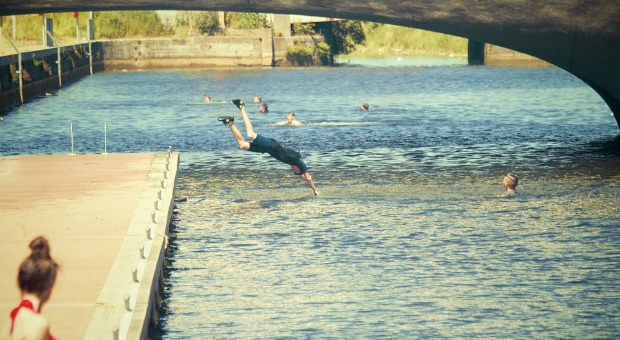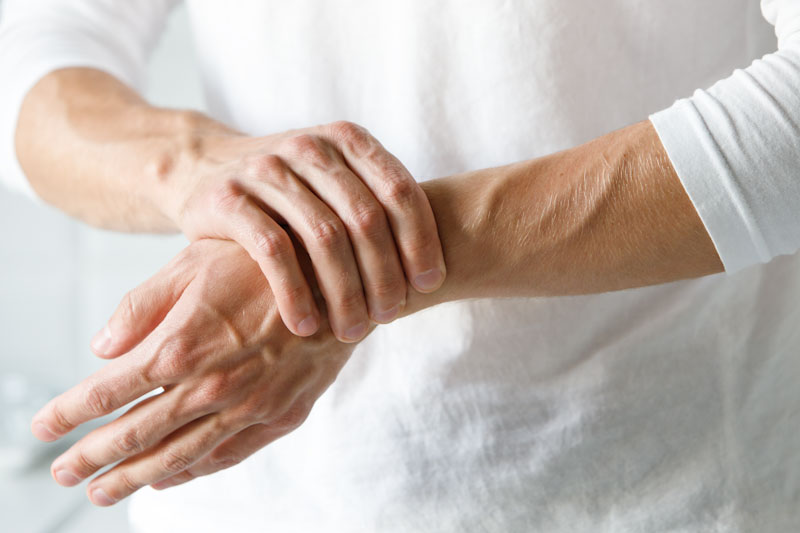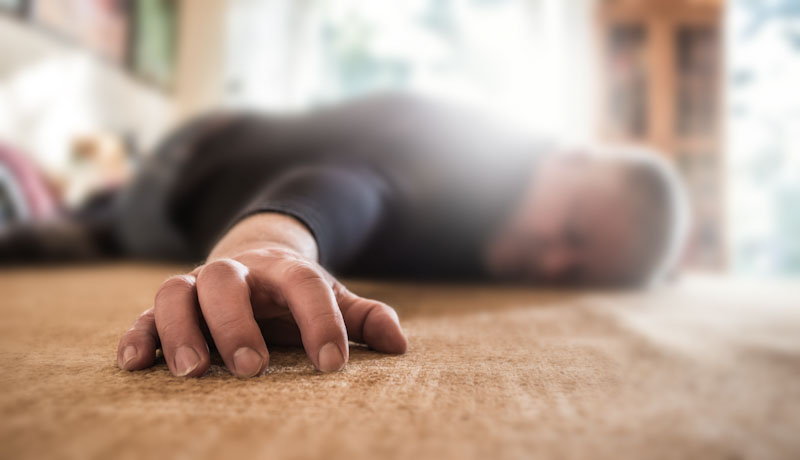While falls can be very surprising, knowing what to do and practicing those techniques can save your life and minimize injuries.
Chances are, you know of at least one or two people that think nothing of sky diving, bungee jumping, or performing stunts that entail knowing how to fall correctly.
For the rest of us, however, even falling from a standing position can be a fearful matter. For at risk populations, even a minimal fall can cause broken bones or other serious injuries.
Learning how to survive different kinds of fall is very important so here is where to start from.
Greater Heights Onto the Ground
If you go hiking, you have climbed up a few hills, or perhaps even ventured onto an outcropping that gave way on you. Also, if you live in an apartment building, in the worst case scenario, you may wind up falling out a window, or worse yet, be pushed through one.
Even though any of these situations can lead to extensive injury, you may still be able to survive a long fall if you use the following strategy:
- Break your fall as much as possible. Reach out for anything that you can grab onto, even if it doesn’t look like it will hold your weight. Anything that you grab onto will absorb some of the energy from the fall. If nothing is available, try to bump your body into the side of the building, or anything else that you can brush against. This won’t absorb as much energy as grabbing onto something, but it is better than nothing.
- Regardless of the height you are falling from, it is also important to try and orient your feet so that they point to the ground. This will set you up so that the greatest amount of impact will be on your hips and legs instead of your head or vital organs. In addition, when your feet are pointing to the ground, you can bend your knees slightly, which will have a significant reduction in how hard you actually hit the ground.
- Finally, you will need to make sure your body is as relaxed as possible. Any muscle or joint that is tense at the time of impact is likely to be torn. As much as you may want to tense up, going limp is truly the best thing you can do. Practice using trigger words that create an immediate release in body tension so that you can use them in any situation.
On the Ice or Uneven Pavement
Chances are you’ve slipped on a wet floor, broken pavement, or even ice at some point in your life. If you were lucky, your injuries were minimal and you were able to go on with your life.
There are many people today that are susceptible to broken bones or other serious injuries that can happen when you fall.
Learning how to break your fall from short distances is every bit as important as learning how to manage long falls.
Here are the basic steps you should follow:
- Unlike a long fall, you won’t have time to orient your body or try to break your fall. As such, your best option will be to go limp so that you reduce the force of impact as much as possible.
- Land on your side with your head tucked in for safety. Try not to land on your knees, hands, back, or chin. All of these positions can lead to broken bones, strains, and other injuries.
- Try to curl yourself up into a ball so that you can roll. During a short fall, you can spread out the force of the impact by using it up in a roll. This effectively gives a wider surface area, so there is less force going through your body. There are many techniques for rolling. For example, you may have learned to simply squat, tuck your head into your chest and roll in grade school gym classes. Today, you can also go for martial arts training and learn many different techniques. If you meet some kind of adversary that tries to push you to the ground, you will learn how to use rolls as an evasive maneuver.
- It is also very important to avoid sharp or dangerous objects that can do damage if you land on them. Try to push your body so that you don’t land on these items.
Video first seen on GMB Fitness.
From a Bike
While falling from a stationary base such as a building or the ground is dangerous, falling from a moving object is even worse. For example, if you fall from a bicycle, your injuries will be even worse because the momentum of the bike will serve to throw you even further.
There are four ways that you can be thrown from the bike, and also four techniques you can use to reduce injury as much as possible:
- Over the Handle Bars – if you are thrown to the front of the bike, it is very important to tuck your head into your chest and extend your leading arm. This is the arm that will absorb most of the impact of the fall. As soon as you impact with the ground, it is very important to start rolling onto your leading arm shoulder and continue until you stop. It is also important to note that your bike may also have been thrown forward, and is likely to land on top of you. Shield your head, face, neck, and back as much as possible by curling into a ball and lay on your back.
- Over the High Side – you can also be thrown from your bike if the front wheel comes off the ground and the frame starts to twist. For this type of fall, your body will be propelled sideways and may hit a building or the sharp part of the curb. Release your hands from the handles and make sure that your feet are not tangled up in the pedals. The best you can do with this situation is tuck your head in and curl yourself up into a ball. Let your body go limp so that when you do land, you will do as little damage as possible to your body.
- From the Low Side – if your bike falls sideways, your body will be dragged along with it. In this situation, you will also more than likely slide along the pavement until the bike (and you) come to a stop. To minimize injury in this situation, try to get your lowermost shoulder aimed at the ground as it provides a broader base for the impact to spread on. You can also try putting your feet out in front of you in order to slow your momentum as much as possible.
- Slow Sideways Fall – to the outside observer, this fall may not look very serious because it happens so slowly. Unfortunately, that lack of speed does not give you a chance to reduce the force of the impact by rolling. If your bike falls sideways slowly, lean away from the ground as much as possible. Let the bike fall to the ground as you try to stand up. As the bike hits the ground and moves your body along, once again roll onto your shoulder and then your back. This maneuver can keep you from breaking a hip or elbow.
From a Moving Vehicle
As with being thrown from a bike, there aren’t many ways to avoid injuries if you are thrown from a car. In fact, you will have more to be concerned with because the speeds involved may be higher, and the vehicle will land on top of you.
That being said, you can still try to use the following strategies to minimize your injuries and save your life:
- Make sure that your elbows and knees are as well padded as possible. If you are driving with someone that you don’t know, or you are concerned for some other reason, it never hurts to wear knee and elbow pads.
- It is also very important to pay attention to traffic and the road even if you aren’t the one driving. Depending on the rate of travel, you should be able to determine that a crash is happening within 3 to 5 seconds of the actual crash. If you know how to jump from a vehicle, you will need to use this time frame to do so. While this is a dangerous maneuver at low speeds, it may be a bit safer than being thrown from the vehicle. Sadly, even if you are wearing a seat belt, the impact of the crash can still cause you to slip out of the belt, and then out of the vehicle.
- No matter whether you are thrown from the vehicle or jump out, going limp is very important. You will also need to roll so that you minimize the impact as much as possible. In this case, you may have to roll several times so that you break as few bones as possible. Rolling a few extra times may also help you to avoid having the car land on top of you.
- Once you stop moving, try to get out of the way. Put something like a tree or anything else that will catch the car and stop it before it reaches your position.
Into a Pool or Calm Water
While you may not give it much though, there is a huge difference between diving into a pool on purpose and being thrown into one or fall in by accident. When you are surprised by the loss of balance, it is all too easy to do things that will lead to drowning.
Here are some important steps to take if you realize that you are going to fall into a pool or some other type of calm water:
- Inhale. If your lungs are empty when you hit the water, you will have less time to get to the surface before you are forced to take air in.
- As with any other fall, let your body go limp so that you impact the water with as little force as possible. Even though you may not be falling from a great height, the surface tension of the water will still provide some resistance.
- Once you are in the water, try to spread your arms and legs out and turn over on your back. Your face should be pointing upward. If you do not know which direction is up, exhale a little bit and observe which direction the bubbles go in. Since they will always go up, simply turn yourself in that direction. When your body is laying flat and spread out, it is possible to float up to the surface. Alternatively, if you already have your bearings, you can start swimming towards the surface.
Greater Heights Into Water

Right now you may be inclined to think that, as a liquid, water should make a nice soft cushion to land on. As a liquid, however, water has surface tension that keeps it somewhat in place. If your body falls into water from a great height, the water molecules can’t get out of your way fast enough. As a result, landing on water is just as bad, if not worse, than landing on concrete.
It is also important to note that when you take a long fall into water, there may not be anything to help break your fall along the way. Breezes and wind can push your body off course. If the air happens to be moving in a down draft, it can push you towards the water even faster and harder. No matter how hard you try to position yourself, it is all too easy to get pushed off course or into the wrong orientation.
That being said, you can still try the following steps in time of need. This is not something to practice, however just keep this information in mind in case it is needed.
- As with any other fall, let your body go as limp as possible.
- Orient your body so that your body is bent as if you are sitting in a car seat. Your feet should be positioned so they hit the water first. The idea is to have as small a body area as possible hitting the water so that less water needs to be pushed out of the way. Bending at your knees and hips also takes the direct line of impact away from your major organs.
Even though falls can cause a lot of injuries, there is a chance to survive them. Knowing how to position your body based on the type of fall is very important.
You should also practice different kinds of falls and rolling techniques so that you do them as well as possible when needed.
Will you be able to protect your own in a life or death scenario?
Click the banner below to find out!
This article has been written by Carmela Tyrell for Survivopedia.







